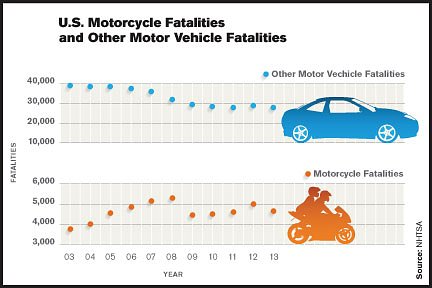Based on figures from the first nine months of 2013, a report by the Governors Highway Safety Association suggests that motorcycle fatalities will be down slightly in 2013, the first time since the GHSA started keeping these stats in 1997 that deaths have declined for two straight years.
That's the headline. After digging into the report, here's what I take away as the meaning for those of us who are serious riders: As much as we love to blame "cagers," if we want to arrive alive, it's still mostly up to us. And that mainly means making smart choices.
Here are the statistics in the GHSA report that stuck out to me. First, in 1997, motorcyclists represented 5 percent of fatalities on the road, but 14 percent in 2013. That's not because things are worse among motorcyclists, but because fewer drivers in cars and other vehicles are dying. I think we can all recognize that passenger cars have gotten considerably safer over the past 20 years while motorcycles are still, mostly, motorcycles.

These aids are helpful and are becoming more common, but while car drivers can count on their air bags, crumple zones, warning systems, ABS and other features to keep them safer, for the most part, we motorcyclists still need to rely on ourselves, not on technology. We have to make smart choices. And that brings me to three more statistics in the GHSA report.
- About 30 percent of motorcyclists who died had been drinking.
- Last year, 25 percent of motorcyclists who died did not have a valid license.
- In about 34 percent of fatalities, the rider was speeding.
These are easy choices to make. Drink when you're done riding. If you're not serious enough about riding to bother getting a license, find a safer hobby. (And if you are serious, recognize that passing the test to get your license is not real "training." It's the beginning of your learning, not the end.) And third, be smart with the throttle hand.
That third topic deserves a little more thought, because it's less simple than the first two. Regardless of what we ride, almost all of us enjoy the performance motorcycles provide. We love that feel of power surging out of a corner. I'm not saying you have to putter around at 25 mph to keep from dying.
I'm just saying — again — that we have to make smart choices.
Probably this is on my mind because of the recent weekend I spent listening to two notable riding instructors who teach riders day in and day out how to be safer — without giving up fun.

On some of my favorite roads near where I live, there are some curves marked with 25 mph advisory signs. I have taken those curves at 55 mph with no drama, no knee down, still keeping a margin. There are other curves on the same road with 25 mph advisory signs where I know I probably should be going not much more than 25 mph.
What's the difference? The first curve has long, open sight lines and the second is blind. Taking the latter at 55 mph may mean suddenly confronting a deer standing in the road, a truck with a flat tire and no shoulder for getting off the pavement, a slow-moving piece of farm equipment, or any of a dozen other hazards, with not enough time to avoid them. Outriding your sight lines is motorized Russian roulette. You may win a thousand times in a row, but it only takes one loss to get the "game over" message. The same is true for riding too fast for conditions, whether that means the weather, traffic, nighttime, your own fatigue, etc.
Let's keep motorcycle fatalities going in the right direction, and not just because of better technology in our motorcycles. The greatest safety feature of all is the brain of the rider. Make sure it's fully engaged each time you ride.









